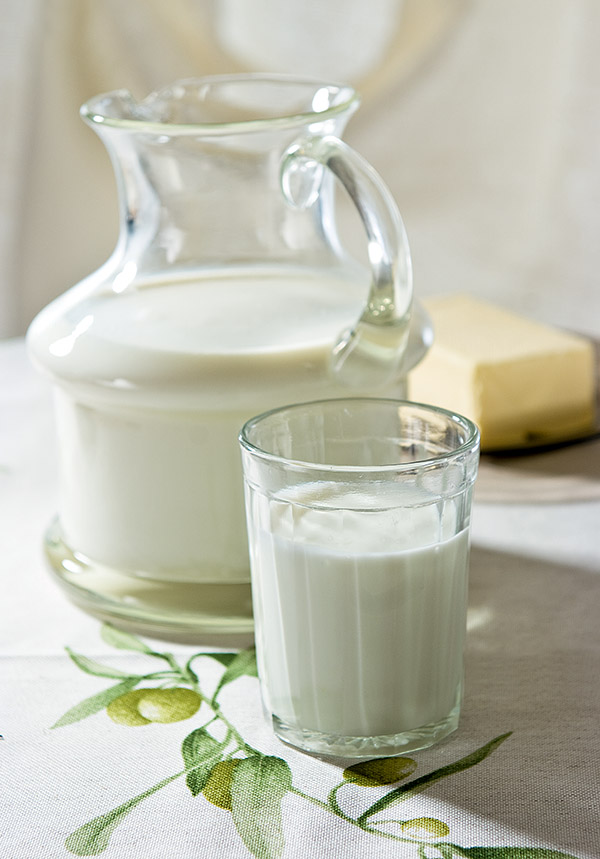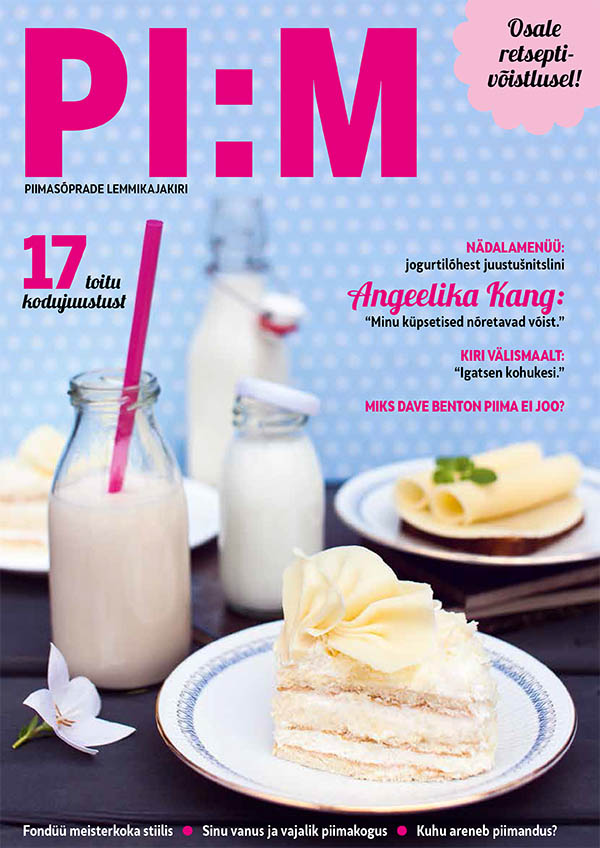milk | butter | kefir | cheese | yogurt | sour cream | buttermilk | sour milk | cottage cheese | curd | pudding
Buttermilk is Biologically a Valuable Food Ingredient
Buttermilk is either a fresh or fermented by-product of butter making. Fermented buttermilk has been highly valued and consumed in Estonia over the ages. As it is biologically a very valuable food in terms of health compared toother fermented milk drinks, buttermilk has undeservedly been in the background nowadays.
Macronutrients in Buttermilk
Water content in buttermilk at its highest is 91–92%. A high water content allows the use of buttermilk both for maintaining the water balance of the human body and as a quick thirst quencher.
As the water content of buttermilk is mainly bound to proteins, it is absorbed from the intestines slowly enough that this drink is better than any type of water, either ordinary or flavoured.
The dry matter in buttermilk (8–9%) contains macronutrients (milk proteins, carbohydrates, lipids) and micronutrients (mineral substances, vitamins). Fermented buttermilk contains nutritious milk proteins (up to 3 grams per 100g of buttermilk) that have a very high biological value for the human organism.
During fermentation, proteins in the buttermilk become even more digestible and their allergenicity is reduced or disappears for certain consumers.
The carbohydrate content of buttermilk on sale in our stores is between 4.3–4.5%. The majority of it comprises lactose or milk sugar, and to some extent glycose and galactose that are generated during the cleavage of lactose.
And this provides another added value. People who have problems with lactose in fresh milk may successfully drink fermented buttermilk. The reason for it is that the lactic acid bacteria of the starter have partially consumed the lactose for their own needs, i.e. the enzymes secreted by them in the fermentation
environment have decomposed part of the milk sugar in the product.
And there are more benefits, namely, the lactic acid bacteria of the starter synthesize lactic acid from milk sugar. This organic acid helps to absorb calcium and it also gives buttermilk its sour taste. Sour buttermilk stimulates the function of the gastrointestinal tract of people who suffer from stomach hypoacidity. Adults who have problems with indigestion should drink a glass of buttermilk on an empty stomach.
The fermented milk on sale in Estonia belongs among the food products that contain so-called living microbes. Living lactic acid bacteria in the fermented buttermilk help buttermilk consumers to restore the natural microbiological habitat in their intestines, and thus foster the digestion and absorption of some nutrients.
Due to the presence of living bacteria in the product it should be stored at a cold temperature. In the warm, the vital functions of lactic acid bacteria accelerate and they convert more milk sugar into lactic acid. As a result, the taste of the product becomes more sour than may be acceptable to the palate of many people.
Only recently, biobuttermilk drinks were also produced in Estonia. They contained buttermilk, fatless milk and an additional substance of which the content was up to 14%. The name biobuttermilk was used due to the fact that probiotic bacteria were used during fermentation. The additional substances were aloe vera, blood orange or grapefruit. Compared with ordinary buttermilk, the biobuttermilk drinks contained more carbohydrates (mostly due to their higher content of glycose, fructose and sucrose).
Due to the higher carbohydrate content, biobuttermilk drinks contained more calories compared with ordinary buttermilk. The content of other nutrients, such as proteins and fats, in the biobuttermilk drinks, on the contrary, was the same as in the ordinary buttermilk.
As the fat content of buttermilk is very low (usually 0.5% or lower) it is a very suitable thirst quencher for those who watch their figure. The biological value of buttermilk fats is also in the fact that they contain the phospholipids, mainly lecithin, that are necessary for the human organism.
Milk lecithin is mainly concentrated in the membranes of fat globules. When making butter, the membranes of the fat globules are destroyed; by conjoining the milk fats butter is formed and the majority of lecithin, together with milk sugar, stays in buttermilk.
The human body needs lecithin for several purposes: in the composition of cell membranes, for normal brain function, and for replenishing the supplies of choline or vitamin B4. Often it is advised to use lecithin preparations but it is easier, more natural and cheaper to eat food products rich in lecithin that also provide a certain amount of other necessary phospholipids.
The energy value of fermented buttermilk is determined by the carbohydrates and proteins in its composition. Due to their comparatively modest quantity the calorific value of fermented buttermilk is rather low. If you drink 200 grams of buttermilk, you get only around 56–70 calories of food energy.
Micronutrients in Buttermilk
The content of calcium and phosphorus compounds in buttermilk is more or less similar to that of cow’s milk. Buttermilk is a very good source of potassium. A glass of buttermilk gives a nice amount of magnesium too. Buttermilk contains more water-soluble vitamins than the fat-soluble ones. This is due to the specific composition of buttermilk, as depending on the manufacturing technology it contains rather a small amount of milk fats.
During fermentation, buttermilk is enriched with various B-group vitamins. This dairy product
is a substantial source of the vitamin B2 that is suitable for the human organism.
Various Applications
Buttermilk is a superb food product. If drinking buttermilk isn’t enough to stave off hunger, you can mix it with kama (a traditional Estonian meal containing milled rye, wheat, barley and peas) to get a versatile, useful and easy meal.
If you think the taste of the fermented buttermilk too dull you can blend in jams, berries, vegetables or green herbs to make drinks with various flavours. Their calorific value is definitely higher, though.
Fermented buttermilk is perfect as the main component in the cold soups that are very popular during the warm season.
Even today, buttermilk is used in the composition of various doughs and batters, especially when raising agents are added to them.
Due to the interaction of the organic acids in buttermilk and raising agents the separating gases make the pastry fluffy. Liquid buttermilk is a suitable component in pastry and baked curd dishes.
KYou can use buttermilk at home as a high quality starter for fermenting milk. You have only to add about 5‑10% of fermented buttermilk to milk, mix them well and let it ferment at room temperature. The bacteria in the starter of the fermented buttermilk ensure a high quality result both in terms of texture and taste.
The organic acids (mainly lactic acid) in buttermilk are used for various culinary and cosmetic applications. The mild acid environment of buttermilk is very good for marinating meat and as a base of mild marinades.
Lactic acid has also a skin peeling effect so buttermilk can be used in cosmetic skin care products.
Buttermilk is widely known outside Estonia as well. For example in Ireland, buttermilk and garlic are considered to be a universal medication against colds. In many countries, buttermilk is thought to be a good means of easing stomach disorders after the excessive consumption of alcohol.
Due to the special biochemical composition of buttermilk, buttermilk powder ‑ the concentrate of dry matter in buttermilk ‑ has wide application in food industry. Buttermilk powder is often used in whipped creams, mainly due to its lecithin and protein content. Specifically, lecithin has twin characteristics – part of its molecule binds well with water, the other part with fats, so it is a good emulsifier, binding the two phases in creams into one whole, and building bridges between them on the molecular level.
The success of lecithin as an emulsifier is proven by its use as a food additive (E322). The proteins of buttermilk powder play a role in creams as well – they stabilize whipped preparations by encapsulating microquantities of air in them. And of course, using a relatively fatless buttermilk powder in creams serves another purpose – it reduces their calorific value.
On certain occasions, buttermilk powder is also added to fermented mixed milk drinks; its purpose then is to improve the nutritional and biochemical characteristics of the product.
Share ►



